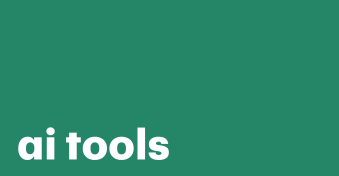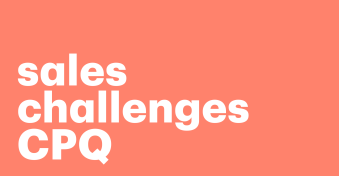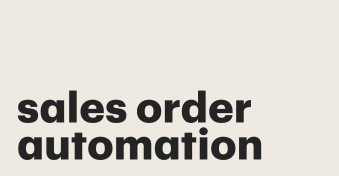A deal desk streamlines deal management and enhances win rates — if the process flow is set up correctly.
This article outlines steps to establish and optimize a deal desk process flow with your team to help advance your sales strategy.
Key takeaways
- A deal desk is a cross-functional team assembled to oversee opportunity qualification, solution and proposal development, and negotiation stages of a sales process.
- Each team member’s position in the deal desk is clearly defined: responsibilities, types of deals they manage, roles in the sales process, etc.
- The deal desk process is a series of steps designed to oversee and move sales deals through a sales funnel until they get signed.
- Automation tools, such as software designed for business proposals or contract management, accelerate collaboration with all stakeholders.
- Analyze your deal desk’s performance by using metrics such as response and resolution time, win rate, deal size, profit, and renewal time.
What is the deal desk process?
The deal desk process represents steps for evaluating and managing both standard and non-standard deals through a sales pipeline.
A non-standard deal, also known as a complex deal, has a longer sales cycle compared to a standard deal, which likely involves only one or two sales reps and requires less time to close a deal.
While part of the broader sales process within a company, a dedicated team optimizing that company’s deal desk process flow ensures that proposed deals are both in the best interest of the company and that the deal approval process is streamlined.
What are the stages that define the process flow of a deal desk?
At the beginning of a sales process, a sales team puts their efforts into collecting and bringing leads into a pipeline.
After that, a deal desk comes into a process in the following phases:
- Opportunity qualification: a deal desk qualifies standard and non-standard deals, evaluating their financial and strategic aspects, as well as potential risks they may pose to a company.
- Opportunity approval: based on the assessments above, a deal desk approves or denies deals to move forward; after a deal gets approved, a deal desk’s main responsibility is to cruise it through the approval process and get it signed.
- Solution development: at this stage, a deal desk is involved in planning a budget, considering the costs of a solution, discounts they can offer to a client, and projecting revenue from cooperation.
- Proposal development: a deal desk applies best practices of an approval workflow, including the use of templates, a knowledge base, and automation tools.
- Negotiation: this stage gathers a deal desk, a sales team, and a client to agree upon mutual terms and conditions.
All activities thereafter, such as payment processing, customer onboarding, and delivery, apply to deal closure and do not need to involve a deal desk.
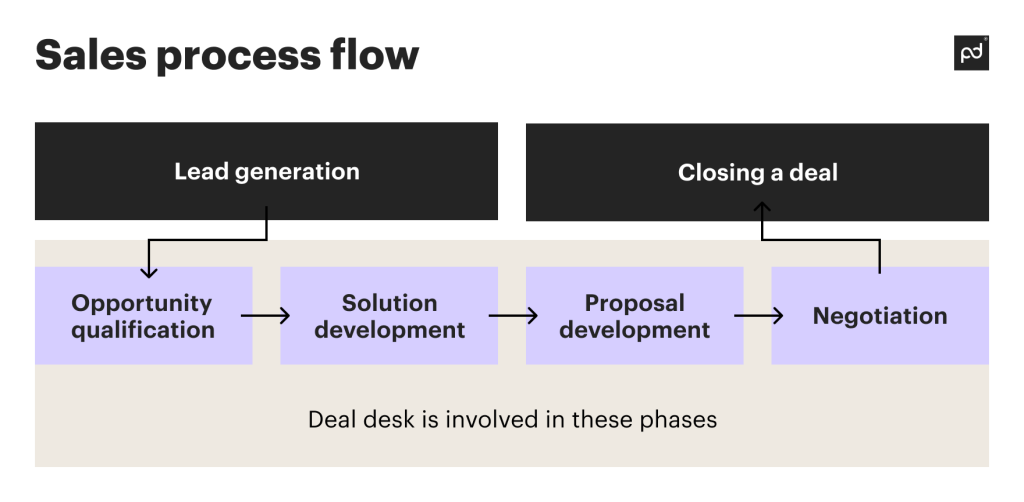
How to set up a deal desk
1. Decide who will work on your team
A basic deal desk team consists of a manager who handles deal management, pricing, and contract negotiation.
In large companies, a deal desk team can comprise as much as 10 people with backgrounds in areas like legal, marketing, product management, or finance.
Although a deal desk team is a mix of different talents, look for candidates with project management skills who excel at planning and executing projects.
2. Define what a deal desk will be doing in your company
To define a deal desk’s function, assess where the sales team needs support and what bottlenecks exist in the deal closure process.
For example, if your sales team struggles with creating proposals on time, assign a deal desk to manage proposals for all types of deals — standard or non-standard — from start to finish.
Here are the most common duties of a deal desk team:
- Oversee complex deals that bring high revenue to a team
- Negotiate a pricing strategy for deals
- Collaborate with different departments and serve as a key advisor to the sales team
- Streamline deal execution
- Manage the approval workflow for deals
- Create a knowledge base and templates
3. Upgrade your tech stack with automation tools
Customer relationship management software (CRM) is a tool extensively used by sales teams to manage, track, and optimize the customer lifecycle.
In addition to a CRM, a deal desk incorporates other automation tools, such as proposal management systems and contract management software, to accelerate a sales process flow.
These tools come with the following features:
A tracking feature
A tracking feature shows you what progress has been made in a document.
As it tracks data in a document while it is moved through teams, you can monitor who accessed the doc and made changes.
A collaboration feature
A collaboration feature helps teams and stakeholders to cooperate within one shared place.
For example, when working on a proposal using PandaDoc, authorized members can edit it simultaneously, use a comments section, and utilize a built-in chat.
An approval workflow feature
An approval workflow feature that moves docs forward for approval, signing, and review automatically.
When customizing approval workflow steps, route a signing order and receive a notification when a doc is signed.
Designate people who approve, manage, and submit docs, set due dates, and reorder approval steps.
With an integrations feature, you can integrate your tools with CRMs, HR systems, and productivity tools to automatically incorporate essential data into your documents.
4. Analyze the success of your deal desk process flow
Use the following metrics to assess how your deal desk process is truly performing.
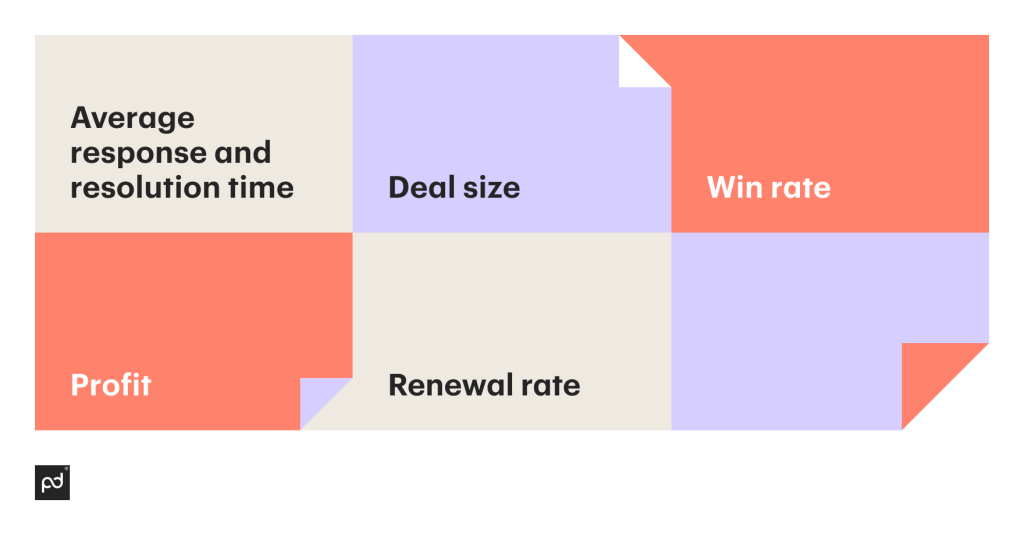
- Average response and resolution time: calculate the average time it takes for a deal desk to close a deal to identify where you have potential roadblocks in the process.
- Deal size: compare if your deal size changes over a period of time to see if you need to adjust how your deal desk interacts within a sales process flow.
- Win rate: get the percentage of deals your team has converted from opportunities to closed deals to assess how a deal desk contributes to achieve the company’s strategic goals.
- Profit: see if your deal desk function pays off by comparing a profit rate before and after adding a deal desk to your company.
- Renewal rate: with this metric, you can estimate an average portion of revenue that can be generated over the entire customer relationship.
Keep advancing how your deal desk flow operates — schedule regular review sessions, ideally synchronized with revisions to your sales processes.
Final thoughts
A well-defined, responsive, and agile deal desk process flow is key to acquiring, qualifying, and closing better deals in a sales pipeline.
It all starts with the cross-functional team you assemble and the tools you arm them with to streamline the deal management process.
A proposal management system provides a deal desk and stakeholders a clear view into every stage of a deal, offering the ability to track changes, collaborate on documents, and securely eSign them. Schedule a 15-minute demo to see how PandaDoc’s proposal management system can advance your deal desk process flow!
Disclaimer
PandaDoc is not a law firm, or a substitute for an attorney or law firm. This page is not intended to and does not provide legal advice. Should you have legal questions on the validity of e-signatures or digital signatures and the enforceability thereof, please consult with an attorney or law firm. Use of PandaDoc services are governed by our Terms of Use and Privacy Policy.
